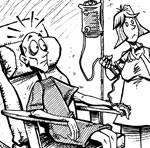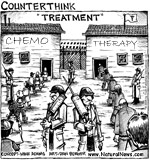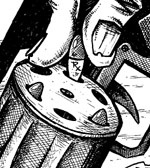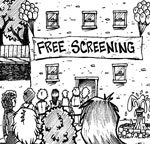L-Carnitine for Weight Loss
| Share on Facebook | Share on Twitter | Share on Google+ |
One of the most popular applications of the amino acid L-carnitine is as a fat burner. But a combination of L-carnitine, R-lipoic acid, and the B vitamins biotin and nicotinamide helps burn both fat and sugar faster. Let's take a look at L-carnitine's role in fat metabolism and why the versatile antioxidant R-lipoic acid and the two aforementioned B vitamins help it work even better.
L-Carnitine is Not An Ordinary Amino Acid
The human body typically uses amino acids to build protein or to make neurotransmitters. L-carnitine is not used for either purpose. L-carnitine has a chemical structure similar to the amino acids, and is classified chemically as an amino acid, but it has a function more similar to a vitamin.
The similarity of L-carnitine to vitamins lies in its ability to regulate fat burning. The L-carnitine molecule carries fatty acids out of the bloodstream and into cells, delivering them to the mitochondria where they can be burned. Prerequisite to this process, of course, is getting fatty acids out of fat cells and into the bloodstream. I'll have more to say on that in a moment.
L-carnitine is not a vitamin because it is not "vital" to get L-carnitine from the diet. The body can make L-carnitine from the essential amino acids lysine and methionine. The enzymes that regulate this process in turn depend on vitamin C, thiamin (vitamin B1), niacin (vitamin B3), pyridoxine ( vitamin B6), iron, and manganese. If any of the ingredients for making L-carnitine is being used for some other purpose, then the body needs to get L-carnitine from food or supplements.
Where Do We Get Extra L-Carnitine?
The word "carnitine" has the same origins as the words "carnal" and "carnivore." L-carnitine is concentrated in meat, specifically in muscle meats. Vegetarian diets do not provide L-carnitine, and they also provide relatively lower amounts of the amino acids lysine and methionine the body uses to make it.
Beans and legumes contain very little or no methionine. Wheat, corn, and rice contain very little or no lysine. It is necessary to eat both servings of both beans and legumes and grains every day to give the body the raw materials it needs to make L-carnitine from a vegetarian or vegan diet. Or one can simply take L-carnitine supplements.
Not all animal foods are good sources of L-carnitine, either, as the table below shows.
| Food | L-Carnitine (mg) Per 3-1/2 oz (100 g) Serving |
| Beef Steak | 95 |
| Milk | 38 |
| Pork | 28 |
| Cod Fish | 6 |
| Ice Cream | 4 |
| Chicken Breast | 4 |
| Wheat Bread | 0.4 |
| Wheat Bread | 0.2 |
| Macaroni | 0.2 |
| Peanut Butter | 0.1 |
| Brown Rice | 0.05 |
| Apple Juice | 0.01 |
| Egg | 0.01 |

L-carnitine is most abundant in red meat. Other complete-protein foods provide the amino acids the body needs to make it, but it is also necessary to get the vitamin C, B vitamins, iron, and manganese for the body to use lysine and methionine to make L-carnitine.
What Is the Difference between L-Carnitine and N-Acetyl-Carnitine?
Not to be confused with N-acetyl-carnosine, N-acetyl-carnitine is the form of L-carnitine that the mitochondria actually use. They can make N-acetyl-carnitine by adding acetate to the "N end" of the L-carnitine molecule. The advantage of using N-acetyl-carnitine over using L-carnitine is that it also helps the mitochondria use more sugars as well as more fatty acids.
L-carnitine only helps the mitochondria use a limited amount of sugar. As one of the products of "burning" sugar builds up, less less L-carnitine is changed into the N-acetyl-carnitine form of the molecule the mitochondria need to burn sugar. Taking supplemental N-acetyl-carnitine bypasses this limit in the sugar burning process.
Another advantage of N-acetyl-carnitine over L-carnitine is that cells can use it even if you have not eaten recently. L-carnitine is transported inside of cells with the help of insulin. In people who don't have diabetes, there is a surge of insulin production after you eat a high-carbohydrate meal that helps your cells absorb L-carnitine. N-acetyl-carnitine can enter cells at any time and increase carb burning, as well as fat burning, even without your having to eat a meal to burn more calories!
N-acetyl-L-carnitine can also cross the blood-brain barrier to be used as an antioxidant and neuroprotectant.
The nomenclature of N-acetyl-carnitine gets a little confusing. N-acetyl-carnitine is the same thing as acetyl-L-carnitine, the "L" being understood because only L- forms of carnitine are beneficial. If you could find D-carnitine or acetyl-D-carnitine, or acetyl-DL-carnitine, you should not use them, because they are a different chemical the body cannot use. D-carnitine is toxic, but it does not appear in any products recommended by the owner of this site.
How Do I Use L-Carnitine or N-Acetyl-Carnitine for Weight Loss?
Earlier in this article, I promised to reveal how to use L-carnitine and N-acetyl-carnitine for maximum weight loss benefits. The key to using these products effectively is to time them so that they burn fat released from your fat cells, not just fat digested from your food. 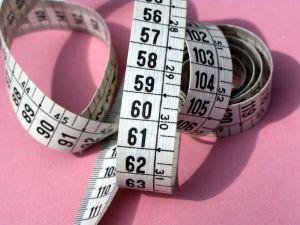
For L-carnitine and N-acetyl-carnitine to burn belly fat, first the fat cells in your fat layers have to let go of their fat stores. You will burn much more fatter if you take L-carnitine or N-acetyl-carnitine on an empty stomach, especially if you have not eaten for more than 12 hours.
I know countless diets tell you that you need to snack constantly to lose weight. L-carnitine and N-acetyl-carnitine are also helpful if you snack. They are just a whole lot more helpful if you fast. Here is why.
How You Can Make N-Acetyl-Carnitine a Better Fat Burner
There are at least three steps for burning fat.
1. The fat cells have to release fatty acids into the bloodstream.
2. The fatty acids have to be absorbed from the bloodstream into the cells that will burn them for fuel.
3. The mitochondria in the fat-burning cells have to use the fats for fuel.The important thing to remember is that fat cells do not store fat and burn fat at the same time!
Insulin does not just transport glucose into cells. It also transports fatty acids inside fat cells. When your insulin levels are high, fats stayed locked inside the fat cells that store them.
The counterbalancing hormone glucagon releases sugar stored as glycogen in the fat cells and from the liver. When glycogen is broken down, it release water that is urinated away. You lose water weight.
Glucagon also liberates fatty acids from fat cells so they can be used as fuel elsewhere in the body. But your body does not make large amounts of glucagon until you have gone at least eight hours without eating.
As you may remember, L-carnitine is transported into cells with the help of insulin. That means that your fat-burning cells receive L-carnitine at a time when your fat storage cells are keeping fat locked tight inside.
N-acetyl-carnitine, on the other hand, does not require insulin for transport. Your cells can absorb N-acetyl-carnitine even when you have not eaten recently. You can take N-acetyl-carnitine to increase fat burning at exactly the time your body releases the most fat to be burned.
This principle, by the way, also explains why getting enough sleep is important to losing weight. During the night your body has run through most of its ready energy, and your muscles have begun to produce uncoupling enzymes that allow them to use the protein-bound forms of fat that normally reside in fat cells. Moreover, the epinephrine and norepinephrine your body secretes to wake you in the morning also accelerate fat burning in your muscles.
It's always better, for purposes of fat burning, to eat breakfast later rather than earlier. Eating brunch and skipping lunch would be better still. In fact, not eating for about 48 hours maximizes the release of fatty acids into the bloodstream so they can be burned as fuel, but there are many other issues complicating fasting as a tool for weight loss. I simply recommend taking N-acetyl-carnitine just before bedtime to increase nighttime fat burning. But there are also the three other supplements that increase the burning of sugar.
Adding R-Lipoic Acid, Nicotinamide, and Biotin to N-Acetyl-Carnitine for Even Greater Weight Loss
In 2007, Chinese researchers announced that they had discovered that a combination of R-lipoic acid, the B vitamin nicotinamide, the B vitamin biotin, and N-acetyl carnitine also accelerated sugar burning in the mitochondria of fat cells themselves, preventing the conversion of glucose into triglycerides and triglycerides into fat. This discovery has especially important implications for diabetics trying to lose weight, although this combination of four supplements is helpful for everyone trying to burn more calories.
What the scientists observed is that fat cells are not especially response to N-acetyl-carnitine by itself. And fat cells are not especially responsive to R-lipoic acid by itself. When fat cells were exposed to both N-acetyl-carnitine and R-lipoic acid together, however:
- The mitochondria, the fuel-burning centers of the fat cells, increased in physical size.
- The fat cells absorbed more oxygen to burn both glucose and fatty acids.
- Glucose burning in the cell greatly increased.
The combination of N-acetyl-carnitine and R-lipoic acid also activated a gene called PPAR-gamma. When this gene is activated, the fat cell absorbs more sugar and fatty acids out of the bloodstream. In the presence of these nutrients, however, the fat cell absorbs them to be burned rather than to be stored.
Why the B vitamins are also recommended. When cells use R-lipoic acid, they deplete both biotin and nicotinamide. Chances are you would not experience any kind of B vitamin deficiency as a result of using R-lipoic acid, but the B vitamins are also important to fat- and sugar-burning. It's best to make sure you have enough.
How Do I Use L-Carnitine or N-Acetyl-Carnitine?
If you have a limited budget for supplements, you will get some good from taking L-carnitine for weight loss. The usual dosage of L-carnitine is 1,000 mg a day, although up to 3,000 mg a day may be helpful. Take L-carnitine with meals, preferably at breakfast.
You can get a lot more benefit from N-acetyl-carnitine. The dosage is the same, at least 1,000 mg a day, although up to 3,000 mg a day is helpful. Take N-acetyl-carnitine on an empty stomach, preferably just before going to bed.
Also take up from 200 mg to 1,000 mg of R-lipoic acid daily, along with 100 micrograms of biotin (typically, one capsule) for every 100 milligrams of R-lipoic acid you take. Some brands of R-lipoic acid, like LEF, combine biotin and R-lipoic acid in the same capsule. A single tablet of nicotinamide is sufficient.
Frequently Asked Questions
Q. Is alpha-lipoic acid the same as R-lipoic acid?
A. Alpha-lipoic acid is a mixture of S-lipoic acid and R-lipoic acid. Companies in China that make lipoic acid typically don't separate out the S- and R- forms. Companies in Italy that make lipoic acid usually do.
A lot gets said about the S- standing for "sinister." Actually this just means that crystals of S-lipoic acid rotate light to the left, while crystals of R-lipoic acid rotate light to the right.
The body can use both forms of lipoic acid, but it uses S-lipoic acid between cells, and R-lipoic acid inside cells. Alpha-lipoic acid is about 45% R-lipoic acid, which is the only form of lipoic acid that will accelerate fat- or sugar-burning. If you take alpha-lipoic acid instead of R-lipoic acid, use twice as much lipoic acid, and half as much biotin per 100 mg.
Q. But if I don't eat every three hours, won't my body break down muscle for amino acids?
A. You don't get up in the middle of the night to eat, do you? No one needs to eat every three hours to protect muscle mass. There is a good reason "not-eating" doesn't destroy muscle.
That safety mechanism is growth hormone. Growth hormone builds muscle-and your body makes more growth hormone when you are not eating. Growth hormone ensures that the body uses fat for fuel, not muscle, but when you eat too much, your body doesn't need it. When you overeat, you don't need to protect your muscles from protein loss, so your body doesn't make as much growth hormone.
There's just one catch to relying on growth hormone as the vehicle for fat loss and muscle growth. Accelerated production of growth hormone is not stimulated by eating less. Accelerated production of growth hormone occurs when you eat nothing at all. This means you need a short period of fasting on a regular basis-but you only need to avoid eating for about 18 hours, the equivalent of delaying breakfast or dinner, or skipping them altogether, to tremendously accelerate fat burning while keeping your muscles intact.
Twenty-four hours without eating once or even twice a week is optimal, although the benefits continue for up to about 40 hours of fasting. After that point, you really need to eat even if you are overweight, although your metabolism won't change until 72 hours have passed. It's a lot harder to eat too little than it is to eat too much.
If you can't make yourself fast, don't worry. You can always just use N-acetyl-carnitine as a bedtime supplement. It will work nearly as well.
Q. Is it better to take N-acetyl-carnitine by injection?
A. It would be completely absorbed, but you don't lose much N-acetyl-carnitine from the digestive tract anyway. If you are concerned about loading N-acetyl-carnitine, take an additional capsule. It's a lot less expensive than getting a pharmacist to compound an N-acetyl-carnitine solution and a doctor to inject you with it. Be wary of trainers who make their own solutions for hypodermic injection. These have to be made under super-sanitary conditions to prevent the possibility of serious infections.
Q. When you describe fasting, do you really mean DON'T EAT?
A. If you are nibbling or noshing, you aren't fasting. Fasting means not eating any food at all, although from the standpoint of weight loss, drinking water would be OK. (Religious fasting is a different matter, although fasting for Lent or Ramadan or Yom Kippur actually can be conducive to weight loss. That's just not the reason for those fasts.)
Anytime you are not eating you are fasting. You don't really begin to get a lot of fat out of your fat cells until you have fasted for 18 hours, but think about that for a moment. If you eat a late lunch one day, and brunch the next, you go without eating for 18 hours. That's enough time for the fat in your fat cells to begin to be mobilized so you can lose weight. Stretch your fast out to 24 hours, and you will have mobilized about half a pound of fat. As long as you don't eat like it's going out of style when you break your fast, that's half a pound of fat you'll never see again. Do this twice a week, and over a period of months, you won't even recognize yourself!
How do I not eat for 24 hours? And I might add other questions about fasting, such as, what is my shopping list for when I'm not eating? Or there any special foods I can eat and still say I'm not eating them? Do you really mean DON'T EAT?
Yes, I really mean that you should find other fun things to do for 24 hours, but it's not that hard. Eat a late lunch one day, and an early dinner the next. Or eat a hearty breakfast to carry you through the day-and night. The longer you give your digestive system and your brain to rest and recover from food, the easier it is to shed weight. You'll find that you actually do have the willpower to lose weight-and that's truly liberating!
While you're not eating, however, you still need to keep hydrated. Water is best. Coffee and tea without sugar and cream are OK. And even sodas sweetened with Nutrasweet are not what the dietary fearmongers would tell us. It's better just to drink water, but there is no evidence that the non-nutritive sweeteners do all the terrible things ascribed to them, particularly with regard to fat storage. They certainly do not reactive the fat storage enzymes that deactivated as you take a break from food.
If you are an insulin-dependent diabetic, or if you must take medications with food, don't fast. Everyone should get medical clearance before any reduced-calorie dieting. But for simplicity, there's just nothing better than good old fashioned calorie restriction for taking off the pounds and keeping them off for good. And when you cut out the calories, N-acetyl cysteine will help your body burn fat and sugar even faster.
-
Skin CareMen Skin Care
-
Free ResourcesFree eBooks
-
The natural healing force within each one of us is the greatest force in getting well.Hippocrates
-
What We RecommendIf you do an analysis of the ingredients in a bottle of
 Total Balance and compare with other products you will find that it provides exceptional value for money…even against simple mass produced products with lower bottle costs.
Total Balance and compare with other products you will find that it provides exceptional value for money…even against simple mass produced products with lower bottle costs.
-
